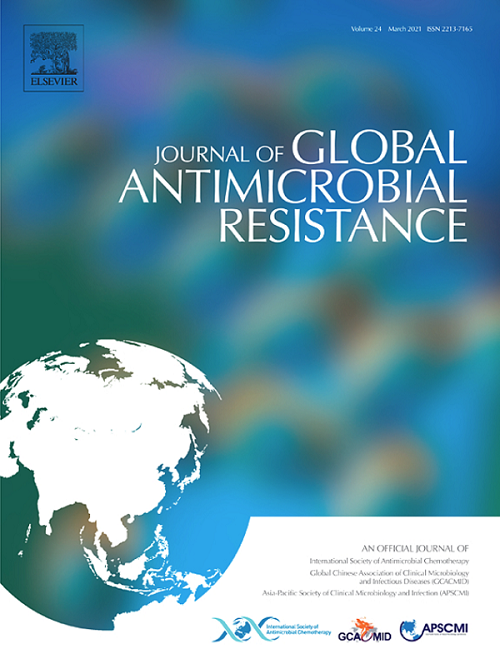LpxC抑制剂对产碳青霉烯酶柠檬酸杆菌临床分离株的活性研究。
IF 3.2
3区 医学
Q2 INFECTIOUS DISEASES
引用次数: 0
摘要
柠檬酸杆菌常见于人体肠道,可引起耐抗生素感染。LpxC是一种参与脂质A合成的酶,其抑制剂已被证明对多种革兰氏阴性菌具有有效的活性,但其对柠檬酸杆菌的活性尚未得到很好的表征。本研究的目的是评价LpxC抑制剂对产碳青霉烯酶的柠檬酸杆菌临床分离株的抑菌活性。测定了61株具有高遗传多样性的临床分离株LpxC-2、LpxC-4和CHIR-090 LpxC抑制剂的mic。用两株低(Cit 52)和高(Cit 110)的柠檬酸杆菌(Citrobacter spp.)菌株对3种LpxC抑制剂进行时间杀伤试验。LpxC-4是最有效的抑制剂(MIC90 = 0.5 mg/L)。总的来说,这三种LpxC抑制剂在含有A型碳青霉烯酶(n = 11株)、B型碳青霉烯酶(n = 39株)和D型碳青霉烯酶(n = 11株)的Citrobacter spp.菌株中表现出相似的活性。所有LpxC抑制剂在4倍MIC浓度下均显示抑菌活性,而在1/4倍MIC浓度下,对两种柠檬酸杆菌菌株在24h无抑菌活性。虽然LpxC-4的MIC90值低于CHIR-090,但CHIR-090在短时间内表现出杀菌作用,并在时间杀伤试验中阻止了两种分离株的再生。在交叉抗性方面,所有三种结构相似的LpxC抑制剂的活性之间表现出中度正相关。本文章由计算机程序翻译,如有差异,请以英文原文为准。
Activity of LpxC inhibitors on carbapenemase-producing Citrobacter spp. clinical isolates
Objective
Citrobacter spp. are commonly found in the human intestine and can cause antibiotic-resistant infections. Inhibitors of LpxC, an enzyme involved in the synthesis of lipid A, have demonstrated potent activity against multiple Gram-negative species, but their activity in Citrobacter spp. has not been well-characterised. The objective of the present study was to evaluate the antimicrobial activity of LpxC inhibitors against carbapenemase-producing Citrobacter spp. clinical isolates.
Methods
The MICs of LpxC-2, LpxC-4, and CHIR-090 LpxC inhibitors were determined for 61 clinical isolates with high genetic diversity. Time-kill assays with the three LpxC inhibitors were performed with two Citrobacter spp. strains, with low (Cit 52) and high (Cit 110) LpxC inhibitor MIC values.
Results
LpxC-4 was shown to be the most potent inhibitor (MIC90 = 0.5 mg/L). In general, the three LpxC inhibitors demonstrated similar activity between Citrobacter spp. isolates harbouring type A (n = 11 isolates), B (n = 39 isolates), and D (n = 11 isolates) carbapenemases. All LpxC inhibitors showed bactericidal activity at concentrations 4× the MIC and no activity at ¼× the MIC at 24 h for the two Citrobacter spp. strains analysed.
Conclusions
Although LpxC-4 had a lower MIC90 value compared with CHIR-090, CHIR-090 showed a bactericidal effect at short times and prevented the regrowth of both isolates in the time-kill assays. In terms of cross-resistance, all three structurally similar LpxC inhibitors showed a moderate positive correlation between their activity.
求助全文
通过发布文献求助,成功后即可免费获取论文全文。
去求助
来源期刊

Journal of global antimicrobial resistance
INFECTIOUS DISEASES-PHARMACOLOGY & PHARMACY
CiteScore
8.70
自引率
2.20%
发文量
285
审稿时长
34 weeks
期刊介绍:
The Journal of Global Antimicrobial Resistance (JGAR) is a quarterly online journal run by an international Editorial Board that focuses on the global spread of antibiotic-resistant microbes.
JGAR is a dedicated journal for all professionals working in research, health care, the environment and animal infection control, aiming to track the resistance threat worldwide and provides a single voice devoted to antimicrobial resistance (AMR).
Featuring peer-reviewed and up to date research articles, reviews, short notes and hot topics JGAR covers the key topics related to antibacterial, antiviral, antifungal and antiparasitic resistance.
 求助内容:
求助内容: 应助结果提醒方式:
应助结果提醒方式:


